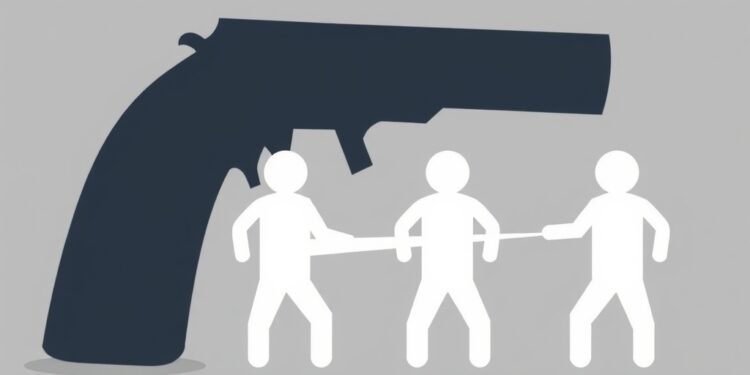The relationship between firearm violence and oral health outcomes in neighborhoods may reveal unsettling truths about the systemic challenges faced by those living in high-crime areas. Researchers from Rutgers University have uncovered a notable correlation between increased incidents of gun violence and decreased dental care utilization among residents of certain neighborhoods. This phenomenon presents an alarming public health crisis, as the implications of firearm violence extend beyond immediate physical harm, affecting vital health behaviors and outcomes.
The comprehensive study analyzed two intricate datasets: one provided by the Centers for Disease Control and Prevention (CDC) detailing dental care usage and rates of complete tooth loss, commonly known as edentulism, and the second from the American Violence Project documenting firearm violence incidents. The researchers focused on 20,332 census tracts within the 100 largest cities in the United States, scrutinizing data collected over an eight-year period, from 2014 to 2022. The findings emerged from methodologies involving data analysis from both the Behavioral Risk Factor Surveillance System and the American Communities Survey.
A compelling discourse has arisen regarding the multifaceted pathways through which firearm violence may impede dental health. Fear and insecurity stemming from chronic exposure to violence can discourage individuals from seeking essential health services, including dental care. Communities plagued by persistent violence often cultivate an environment where the act of visiting a dentist becomes overshadowed by concerns for personal safety. This lack of care not only impacts individual well-being but could also contribute to broader community health disparities.
Moreover, the study sheds light on the psychological toll induced by continual exposure to violence. Residents exposed to such environments may endure heightened levels of chronic stress, which can precipitate detrimental health behaviors. These behaviors include smoking, irregular sleep patterns, sedentary lifestyles, and poor nutrition—all of which are recognized as significant risk factors for oral health complications. The interaction among these factors reveals a vicious cycle where fear and stress lead to suboptimal health choices, consequently exacerbating dental health issues.
The economic impact of community violence further complicates access to dental care. Areas with high rates of gun violence often experience significant disruption of social and economic structures. Families may face financial strains that limit their capacity to afford dental treatments or preventive care. Additionally, the availability of dental care providers may diminish in such neighborhoods, either due to safety concerns or decreased demand, compounding the issue further.
Interestingly, prior to this study, no comprehensive investigations had addressed the implications of community gun violence on healthcare utilization patterns. While the assumption might be that higher violence leads to greater healthcare needs, there exists a paradox where fear of violence simultaneously inhibits individuals from seeking necessary care. This dichotomy becomes particularly pronounced in the realm of dental health, which, unlike primary medical care, is often neglected until significant problems arise.
As emphasized by Daniel Semenza, director of research at the New Jersey Gun Violence Research Center, the ramifications of firearm violence extend deeply into the fabric of public health. This research emphasizes the need for a holistic view in public health advocacy, recognizing that the resolution of violence in communities is pivotal not only for safety but also for the health behaviors of the population. Aligning responses to violence as an urgent public health crisis is essential for supporting healthy communities.
Statistically, the average findings within the study indicated that about 60% of residents had utilized dental care within the past year, although this figure varied drastically across neighborhoods. Some areas reported dental visit rates as low as 18%, while more privileged neighborhoods showed figures as high as 89%. Among older adults, the statistics were just as concerning, with approximately 15% experiencing complete tooth loss annually. The disparities in dental care indicate that systemic issues influence access and utilization of health services.
Concerning gun violence, neighborhoods demonstrated an average of one shooting per year. Yet, the statistic varied significantly as some communities lived through extreme violence with over 100 recorded shootings within a single year. These figures convey a narrative of inequality and underscore the critical importance of understanding the social determinants of health within the landscape of urban violence. This complexity calls for a more comprehensive dialogue on health and safety interventions that not only address violence but also foster health equity.
As a graphical representation of the intricate webs of social disadvantage, the researchers compiled data to generate a composite disadvantage score encompassing various indicators like poverty, unemployment, single-parent households, and reliance on public assistance. This analysis illuminated how combined factors of community disadvantage align with poorer health outcomes, solidifying the idea that these intersecting variables play a crucial role in explaining the observed trends in dental health care utilization.
In conclusion, the study by Rutgers University reinforces the urgent need for collaborations between public health officials, legislators, and community organizations to develop interventions that holistically address the root causes of violence and its repercussions on health. As firearm violence presents a significant barrier to accessing necessary health services, outpouring of support and funding must prioritize health initiatives as integral components of violence prevention. Recognizing health equity as a cornerstone of community safety can galvanize efforts needed to amend these disparities effectively.
By retraining the lens through which we view health, safety, and community resilience, we can aspire to create environments where individuals feel empowered and safe to seek necessary care, thereby promoting better health outcomes for all.
Subject of Research: People
Article Title: Firearm Violence and Dental Health: A Neighborhood Analysis in 100 U.S. Cities, 2014-2022
News Publication Date: 4-Apr-2025
Web References: https://doi.org/10.1016/j.amepre.2025.02.021
References: None
Image Credits: None
Keywords: Firearms, Dental care, Public health, Community violence, Oral health




